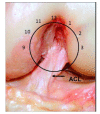The evolution of anatomic anterior cruciate ligament reconstruction
- PMID: 22905073
- PMCID: PMC3415664
- DOI: 10.2174/1874325001206010287
The evolution of anatomic anterior cruciate ligament reconstruction
Abstract
Anterior cruciate ligament reconstruction has evolved significantly since the early 1900's, back when an emphasis was placed on repair and not reconstruction. Over the past century, the technique has evolved from intra-articular non anatomic reconstruction, to extra articular reconstruction, back to intra articular (performed arthroscopically), to now, the advent of anatomic insertion site restoration. This review will aim to illustrate the changes that have occurred, describing the rational for this process, based upon anatomical, radiological, biomechanical and clinical studies, all of which have aimed to improve patient function following ACL injury.
Keywords: Anterior cruciate ligament; evolution.; reconstruction; repair; surgical technique.
Figures






References
-
- Schindler OS. Surgery for anterior cruciate ligament deficiency: a historical perspective. Knee Surg Sports Traumatol Arthrosc. 2012; 20:5–47. - PubMed
-
- Fu FH, Karlsson J. A long journey to be anatomic. Knee Surg Sports Traumatol Arthrosc. 2010;18:1151–3. - PubMed
-
- Loh JC, Fukuda Y, Tsuda E, et al. Knee stability and graft function following anterior cruciate ligament reconstruction: Comparison between 11 o'clock and 10 o'clock femoral tunnel placement. 2002 Richard O'Connor Award paper. Arthroscopy. 2003;19:297–304. - PubMed
-
- Yasuda K, Kondo E, Ichiyama H, et al. Anatomic reconstruction of the anteromedial and posterolateral bundles of the anterior cruciate ligament using hamstring tendon grafts. Arthroscopy. 2004;20: 1015–25. - PubMed
-
- Colombet PD. Navigated intra-articular ACL reconstruction with additional extra-articular tenodesis using the same hamstring graft. Knee Surg Sports Traumatol Arthrosc. 2011;19:384–9. - PubMed
LinkOut - more resources
Full Text Sources
Miscellaneous
